Nail-biting moment camera crew witnesses endangered spider monkey giving birth for the first time ever in the wild… which almost ends in tragedy
Conservationists have unveiled the first-ever video of a critically endangered baby spider monkey being born in the wild: a brown-haired boy they have named Anku.
The newborn spider monkey was born on January 22 this year high in the jungle canopy of the Chocó, a tropical forest in northwestern Ecuador.
The co-founders of the conservation group who obtained the historic video said that during the first nail-biting moments of his life, Anku found himself hanging precariously about 50 feet above the ground, dangling by only his umbilical cord.
The team feared the baby would drop dead. “Luckily that didn’t happen,” said one. “Unbelievable, after all.”
Conservationists have unveiled the first-ever video of a critically endangered baby spider monkey being born in the wild, a brown-haired boy they have named Anku. They said that during the first nail-biting moments of his life, Anku hung 15 meters above the ground – only by his umbilical cord
Eyewitnesses to the birth of an endangered spider monkey are rare in part because the species typically gives birth to its young at night, said conservationist Felipe Alfonso-Cortes, co-founder of the group Proyecto Washu that released the tape.
Wildlife biologists at Proyecto Washu had never even seen a live spider monkey being born – despite having done so has been studying the species in Ecuador for the past ten years.
According to the group, the brown-headed spider monkey is one of the top 25 most endangered primates on planet Earth.

Eyewitnesses to the birth of an endangered spider monkey are rare in part because the species typically gives birth to its young at night, according to conservationist Felipe Alfonso-Cortes (left), co-founder of the group Proyecto Washu that released the rare tape
The monkey’s habitat, thus the International Union for the Conservation of Nature’s Red List of Threatened Speciesextends from western Panama to the western borders of Colombia and northwestern Ecuador.
But according to San Diego Zoo Vice President of Conservation Greg Vicino, these spider monkeys are being driven from their homes throughout these regions of Latin America by human activities.
Spider monkeys are so-called ‘boreal primates’, Alfonso-Cortes said ABC newswho first broadcast the video, meaning they need a safe place high in the trees to survive.
“They don’t get on the ground,” as Vicino of the San Diego Zoo put it.
“There are the jaguars.”
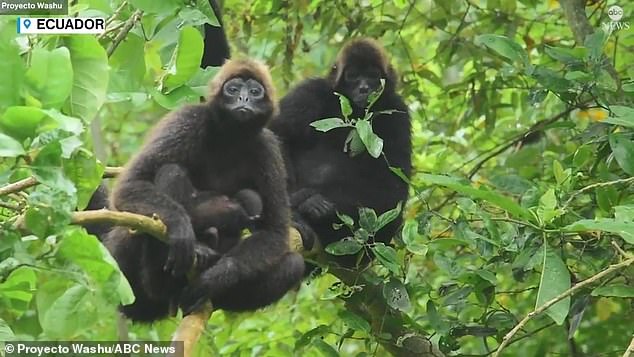
Wildlife biologists from Proyecto Washu had never seen a live spider monkey born before, despite having studied the species in Ecuador for the past decade. The brown-headed spider monkey is among the top 25 most endangered primates on planet Earth, the group said.
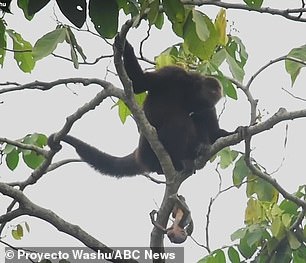
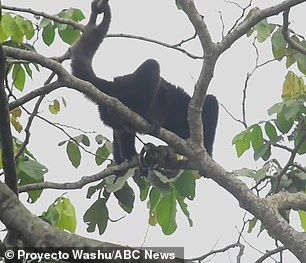
Alfonso-Cortes of Proyecto Washu, a biologist and project coordinator, noted that baby Anku’s birth came as a bit of a surprise because his mother, Arawi (above), is estimated to be 25 – or “very old” for a spider monkey. Arawi also had not had a baby in eight years, he noted
Habitat loss, in the form of widespread deforestation for livestock grazing and for vast plantations growing cash crops such as palm oil, is pushing the species toward extinction, both researchers believe.
But other factors unique to the brown-headed spider monkey have exacerbated the problem, according to Alfonso-Cortes, most notably the primate’s long average lifespan and the long period it takes to raise and raise its young.
A pregnant brown-headed spider monkey (Ateles fusciceps) typically takes more than seven months before giving birth – and once born, a young spider monkey can require breastfeeding for up to four years.
And those long four years, the researcher said, are unlikely to bring about another pregnancy, delaying efforts to boost the endangered monkey’s numbers.
It often takes at least that long before the next pregnancy takes place.
Another factor contributing to the spider monkey’s declining population is the species’ long lifespan, which means older monkeys and younger monkeys have to fight over shrinking living space in those jungle canopies.
Each brown-headed spider monkey can live about 15 to 20 years.
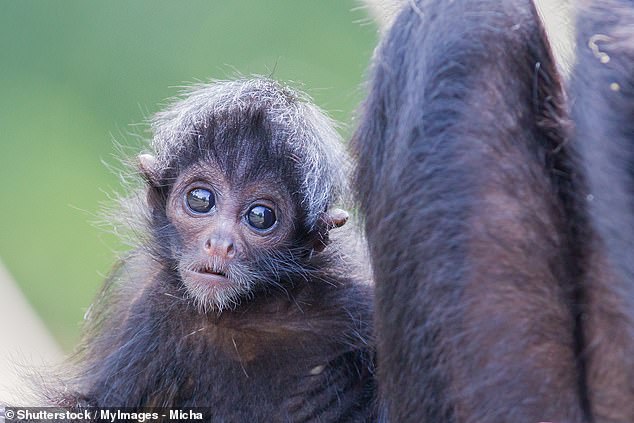
Spider monkeys are so-called “boreal primates,” conservation biologists say, meaning they need a safe place high in the jungle treetops to survive.
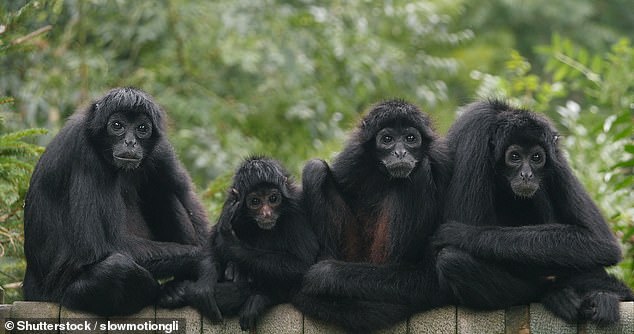
Another factor contributing to the spider monkey’s dwindling population is the species’ long lifespan – meaning older and younger monkeys fight over shrinking living space in the jungle canopy. Each brown-headed spider monkey can live about 15 to 20 years
Alfonso-Cortes of Proyecto Washu, a biologist and project coordinator, noted that baby Anku’s birth came as a bit of a surprise because his mother, Arawi, is estimated to be 25 – or “very old” for a spider monkey.
Arawi also had not had a baby in eight years, Alfonso-Cortes said.
According to Alfonso-Cortes co-founder and colleague Nathalia Fuentes, Anku could possibly have a young girlfriend: Another female spider monkey, Anna, gave birth last Saturday, but she has been much more camera shy.
“Local organizations like Proyecto Washu are nothing short of essential in tackling some of the toughest conservation challenges of our time – from climate change to habitat restoration,” said JG Collomb, the CEO of the Wildlife Conservation Network, which partners with Proyecto Washu, told ABC News.
“The unlikely birth of Anku is a milestone for the brown-headed spider monkey, underscoring the power of community-based conservation,” said Collomb.
Community-based conservation efforts around the brown-headed spider monkey could be significant culturally sensitive, said Vicino at the San Diego Zoo.
Although illegal wildlife traffickers pose a threat to these endangered spider monkeys, which can be dealt with by law enforcement, local indigenous communities are allowed to hunt and eat the primates, which are traditionally part of their diet.
The balance, according to Vicino, will come from protecting and respecting both these critically endangered species and the way of life of the local people.
In other words, as he put it, “How do we develop programs that enable people to live in these places and still make sustainable use of the resources that are there, without depleting them?”
